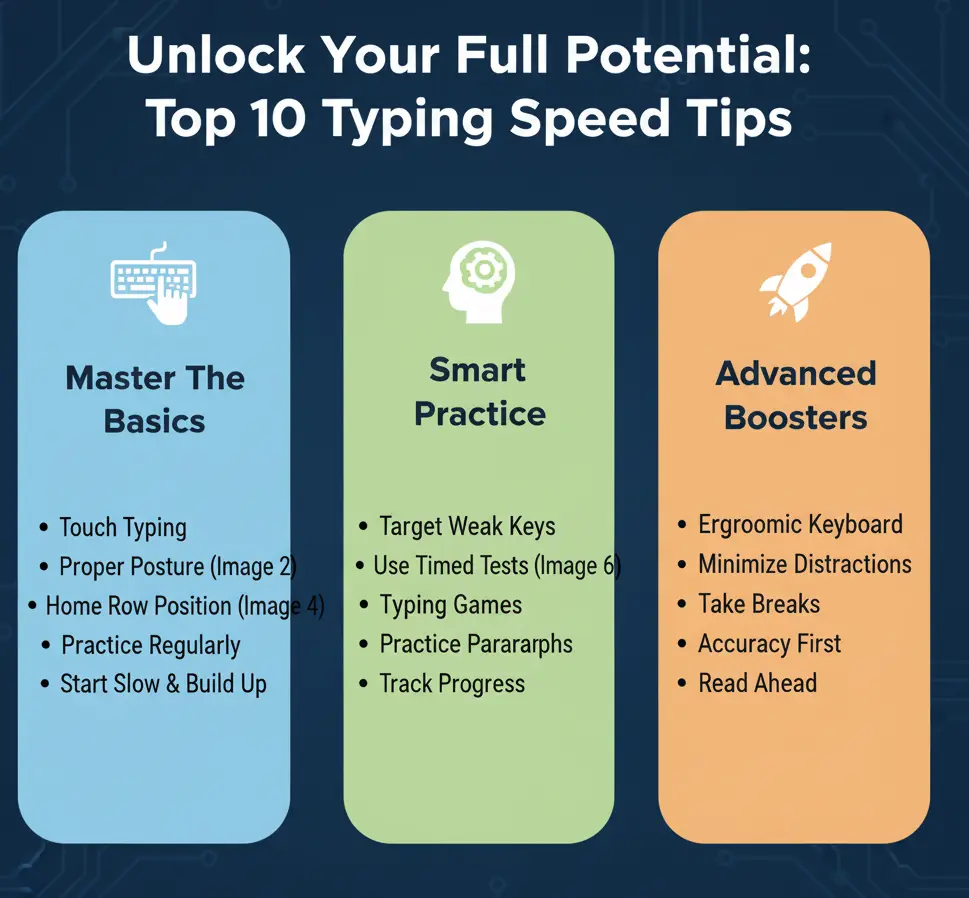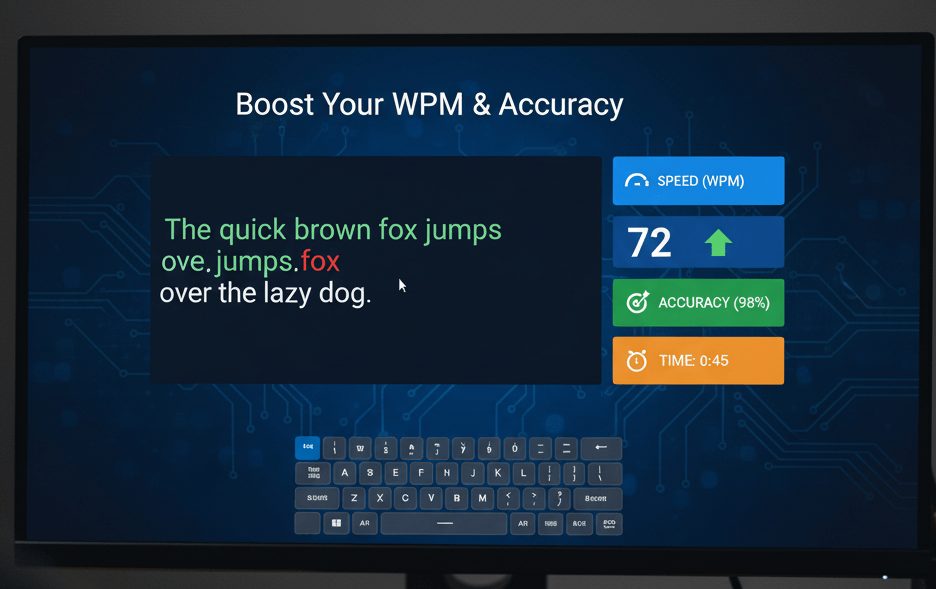How to Really Increase Your Typing Speed (A 4-Week Guide)
Who does not want to type faster? A most rquired skills of the current age. You think a about something, and it appears on the screen. No friction. No frustration. Just pure, fast communication can be done by the the faster typing touch typing skill..
But most of us are stuck. We plateau at 40 words per minute (WPM). We hunt for keys. We hit the backspace button more than any other key. Trying to "go faster" just leads to more mistakes. It's frustrating. The secret? Stop trying to be fast. Start trying to be perfect.

The Golden Rule: Accuracy First, Speed Second
This is the most important lesson you will ever learn about typing. You must slow down to get fast. Read that again. Slow down to get fast.
Why? Because speed is a byproduct of accuracy. It's the result of your fingers knowing exactly where to go, automatically. This is called "muscle memory." You cannot build muscle memory if you are constantly making mistakes. Every time you hit backspace, you are teaching your fingers the wrong path. You are practicing your mistakes.
Think of it like learning to play the piano. You don't learn a song by playing it as fast as possible. You play it slowly. Note by note. You play it perfectly. You do this over and over. Then, one day, your fingers just... play. Speed is the reward for perfect practice.
Your New Goal: 95% Accuracy
Forget about WPM for now. Your new goal is 95% accuracy on every single typing test. If you get 92%, you are typing too fast. Slow down. If you get 85%, you are typing way too fast. Slow down until you can type a full passage with almost no errors. This is the only way to build the right foundation.
Step 1: Fix Your Foundation (Posture & Setup)
This sounds boring, but it's essential. You can't type fast if you are uncomfortable. Bad posture leads to fatigue. Fatigue leads to mistakes. Mistakes kill your speed.
Do this 5-second check right now:
- Feet: Flat on the floor.
- Back: Straight, sitting up in your chair.
- Elbows: Bent at a 90-degree angle.
- Wrists: This is a big one. Your wrists should be floating above the keyboard, not resting on the desk or laptop edge. Resting them slows you down and can cause injury.
- Eyes: On the screen. Not the keyboard.
This setup allows your fingers to move freely. It prevents strain. It lets you practice longer without getting sore. A good setup is the first step to good typing.
Step 2: Master the Home Row (And Stop Peeking!)
This is the hardest part. You must, must, must stop looking at your keyboard. This is non-negotiable. If you peek, you are "hunt-and-peck" typing. You will never get fast this way. Your brain is fast, but your eyes are slow. You need to let your fingers learn.
The Home Row is your anchor. It's your "home base." Your fingers always return here.
- Left Hand: Pinky on 'A', Ring on 'S', Middle on 'D', Index on 'F'.
- Right Hand: Index on 'J', Middle on 'K', Ring on 'L', Pinky on ';'.
- Thumbs: Both rest lightly on the Spacebar.
Feel the little bumps on the 'F' and 'J' keys? Those are your guides. Your index fingers must be able to find those bumps without you looking. This is the core of touch typing.
When you start, you will be slow. If you used to type 30 WPM by peeking, you might drop to 10 WPM. This is normal. It's called "the dip." You have to push through it. It's the only way to build the new, correct muscle memory.
Step 3: Practice with Purpose (The Right Way to Drill)
Just typing random paragraphs online is not the best way to practice. That's a test, not practice. Real practice is targeted. It's focused. It's like a workout for your fingers.
The most important rule: Consistency beats duration. Practicing for 15 minutes every day is 100 times better than practicing for two hours on a Saturday. Your brain builds muscle memory while you sleep. Give it small, consistent lessons to work on.
Drills That Actually Work
- Home Row Drills: This feels basic, but it works. Open a text editor and type:
asdf jkl; asdf jkl;over and over. Perfectly. No mistakes. - Weak Finger Drills: Your pinky and ring fingers are weak. Train them. Type rows of:
qqq ppp zzz ;;;orqa qa pl pl ws ws. - Common Letter Pairs: Type rows of common English pairs.
th th thhe he hein in iner er eron on on. This builds speed for the most common words.
Step 4: Take a Quick Practice Test
Okay, let's put this together. You know the goal is accuracy. You know the home row. Let's try a one-minute test. Remember: Focus on 95% accuracy, not speed. If you make a mistake, stop, breathe, and type the next word correctly. Do not rush.
Step 5: Find Your Rhythm
This is the advanced tip that separates 60 WPM typists from 100 WPM typists. Most people type in fast, jerky bursts. They type a word, pause, type another word. the_quick... brown... fox...
Fast typists don't do this. They type in a smooth, steady rhythm. It's like a metronome. click-click-click-click-click. Each keystroke has the same amount of time. This "flow state" is incredibly efficient. It's much faster than bursting and pausing. Aim for a steady, even pace. It feels slower, but your WPM will actually be much higher.
Step 6: Track Progress (But Don't Obsess)
Tracking your progress is key for motivation. It feels good to see your score go from 30 WPM to 35 WPM to 40 WPM. Use a tool (like this one!) to log your best score each day. But be careful. Do not watch your WPM score during a test. This is a huge mistake. It makes you nervous, which makes you panic, which makes you make mistakes.
Focus on the text. Only look at your score when the test is over. Set small, achievable goals. A great goal is: "This week, I will raise my average accuracy from 92% to 94%." That's a much better goal than "I will gain 10 WPM."
A Simple 4-Week Plan for Students
Here is a simple plan. Do this for 15-20 minutes every day.
Week 1: The Foundation (Accuracy)
- Focus: 100% on accuracy. No peeking.
- Drills (10 min): Home row drills (
asdf jkl;). Weak finger drills (qa pl z/). - Test (5 min): Take a 1-minute test. Your score does not matter. Your accuracy must be over 95%. If it's not, slow down even more.
Week 2: Building Blocks (New Rows)
- Focus: Learning the top row (QWERTY) and bottom row (ZXCVB).
- Drills (10 min): Practice reaching from the home row.
frfjyj(top row).fvfjmj(bottom row). - Test (5 min): Take a 1-minute test with simple sentences. Goal: 95%+ accuracy.
Week 3: Adding Complexity (Punctuation)
- Focus: Introducing capital letters (use the Shift key) and punctuation (.,).
- Drills (10 min): Practice typing
TheAndBut. Practicel.lk,k. Your pinky finger handles Shift. - Test (5 min): Take a 2-minute test with full paragraphs. Goal: 95%+ accuracy.
Week 4: Building Speed (Rhythm)
- Focus: You have the accuracy. Now, you can build speed.
- Drills (10 min): Focus on typing common words.
theofandtoainisyou. Type them over and over. - Test (5 min): Take a 2-minute test. Focus on that smooth, even rhythm. Don't burst. Just flow. Watch your WPM start to climb.
Speed is a Journey, Not a Race
You can do this. The only things required are patience and consistency. Stop peeking. Focus on accuracy. Practice for 15 minutes a day. You will be amazed at how fast you improve. Good luck!
 Typing Practice Hub
Typing Practice Hub